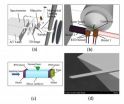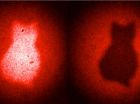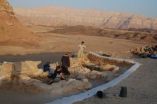(Press-News.org) WEST LAFAYETTE, Ind. – A new research platform uses a laser to measure the "nanomechanical" properties of tiny structures undergoing stress and heating, an approach likely to yield insights to improve designs for microelectronics and batteries.
This new technique, called nanomechanical Raman spectroscopy, reveals information about how heating and the surface stress of microscale structures affect their mechanical properties. Researchers have discussed the merits of surface-stress influence on mechanical properties for decades. However, the nanomechanical Raman spectroscopy has offered the first such measurement, said Vikas Tomar, an associate professor in Purdue's School of Aeronautics and Astronautics.
Surface stress is similar to the surface tension that allows small insects to walk on water, makes water drops spherical, and causes human skin to initially resist a needle's penetration. On the relatively large scale of ordinary, everyday machines, surface stress is negligible, but it becomes critical for micro- and nanostructures, he said.
Recent findings are potentially important because silicon structures measured on the scale of micrometers and nanometers form essential components of semiconductor processors, sensors and an emerging class of miniscule machines called microelectromechanical systems.
"The functioning of such devices has been found to be highly affected by their operating temperature," Tomar said. "Such densely packaged devices generate considerable heat during operation. However, until now we have not been able to measure how heating and surface stress contribute to mechanical properties."
Information about the platform and new research findings were detailed in three papers published this year. The most recent appeared Aug. 15 in the Journal of Applied Physics. Tomar has led the research with former doctoral student Ming Gan, who has graduated and is now working in industry, and current doctoral student Yang Zhang.
In Raman spectroscopy, a laser interacts with the vibrating crystal lattice of materials, providing information about the chemical makeup of the materials.
"But we have not been able to incorporate in-situ stress or deformation into those chemical signatures," Tomar said. "Now we have combined nanomechanical measurements into Raman spectroscopy."
The researchers used the technique to study microscale silicon cantilevers, tiny diving-board shaped slivers about 7 microns thick, or roughly one-tenth the thickness of a human hair, and 225 microns long. The cantilevers were heated and stressed simultaneously. Surface stresses at the micro- and nanoscales were measured for the first time in conjunction with temperature change and a structure's deformation.
Findings show that heating a cantilever from 25 to 100 degrees Celsius while applying stress to the structure causes a dramatic increase in strain rate, or deformation.
The heating reduces bonding forces between atoms on the surface of the structures. The lower bonding force results in a "relaxed" state of the surface or near-surface atoms that progresses as the temperature increases, leading to cracks and device failure.
"The key is to be able to measure thermal and mechanical properties simultaneously because they are interrelated, and surface stress influences mechanical properties," Tomar said.
Findings are potentially important for the measurement of components in batteries to study stresses as they constantly expand and contract during charge-discharge cycles. Ordinary sensors are unable to withstand punishing conditions inside batteries.
However, because Raman spectroscopy uses a laser to conduct measurements, it does not have to be attached to the batteries, making possible a new type of sensor removed from the harsh conditions inside batteries.
"If you don't need onboard sensors you can go into extreme environments," he said. "You can learn how the stresses are evolving so that we can design better batteries."
Such a technology also could be important for development of super-strong composite materials that mimic those found in some marine animals that are able to survive in the extreme conditions found in ocean-floor hydrothermal vents. One obstacle is overcoming stresses that occur at the interfaces of different layers within the composite materials.
"These materials always break at the interfaces," Tomar said. "Now we can understand as the material is deforming how the interface stresses are developing, and this will allow us to predict how to modify them."
INFORMATION:
Purdue has filed a provisional patent for the new platform. The research has been funded by the National Science Foundation.
Writer: Emil Venere, 765-494-4709, venere@purdue.edu
Sources: Vikas Tomar, 765-494-3423, tomar@purdue.edu
Related websites:
Vikas Tomar: https://engineering.purdue.edu/AAE/People/Faculty/showFaculty?resource_id=55699
Purdue School of Aeronautics and Astronautics: https://engineering.purdue.edu/AAE/
IMAGE CAPTION:
A new research platform uses a laser to measure the "nanomechanical" properties of tiny structures undergoing stress and heating, an approach likely to yield insights to improve designs for microelectronics and batteries. Clockwise from upper left, graphics of the instrument setup, and at bottom right a scanning electron microscope image of the tiny silicon cantilever used in the research. (Ming Gan/Purdue University photo)
A publication-quality photo is available at https://news.uns.purdue.edu/images/2014/tomar-nanomechanical.jpg
ABSTRACT
Surface stress variation as a function of applied compressive stress and temperature in microscale silicon
Ming Gan and Vikas Tomara
School of Aeronautics and Astronautics, Purdue University
Surface stress has been shown to affect the mechanical properties of materials at or below the microscale. Surface-stress-induced dislocation activity at such length scales has been shown to be a major factor affecting the mechanical behavior of materials. Defect generation as a function of applied stress at the microscale has previously been measured experimentally and predicted using simulations. However, the change in surface stress in a material in response to externally applied stress as a function of temperature has not been explored experimentally. Such an investigation is presented in this work for the case of microscale silicon samples. In-situ nondestructive measurements of the applied compressive stress and the corresponding microscale surface stress were performed from room temperature to 100 C. The applied stress was controlled by a nanomechanical loading system. Micro-Raman spectroscopy was used to measure the surface stress in-situ as the samples deformed under the applied uniaxial compressive stress. The surface stress was found to be lower than the applied stress at all temperatures. The difference between the surface stress and the applied stress became higher at higher temperatures indicating that surface relaxation was induced by the temperature increase. Based on the measured values and observed trends, an exponential Gaussian function is proposed to describe the stress as a function of surface depth. VC 2014 AIP Publishing LLC. [http://dx.doi.org/10.1063/1.4892623]
New analytical technology reveals 'nanomechanical' surface traits
2014-08-28
ELSE PRESS RELEASES FROM THIS DATE:
Sensory-tested drug-delivery vehicle could limit spread of HIV, AIDS
2014-08-28
A unique method for delivering compounds that could positively impact the global battle against HIV and AIDS may be possible, thanks to researchers in Penn State's College of Agricultural Sciences.
A semi-soft vaginal suppository made from the seaweed-derived food ingredient carrageenan and loaded with the antiviral drug Tenofovir provides a woman-initiated, drug-delivery vehicle that can protect against the spread of sexually transmitted infections during unprotected heterosexual intercourse, the researchers said.
With more than 34 million people worldwide living with ...
The Lancet: Respiratory infection controls being used for ebola patients are unnecessary and may contribute to public panic
2014-08-28
Respiratory infection control measures – which have been adopted by most health agencies to deal with the Ebola epidemic in west Africa – are unnecessary, and may heighten panic and fear among the public, according to the authors of a new letter, published in The Lancet, and written by Professor Jose M. Martin-Moreno from the University of Valencia in Spain, and colleagues.
Ebola virus is primarily transmitted through contact with infected patients' blood, vomit, faeces and other secretions, both direct and indirect, from contaminated needles and other materials. This ...
Indoor mold poses health risk to asthma sufferers
2014-08-28
Damp and mould in homes could pose a significant health risk to people with asthma according to a new study published in the Journal of Allergy and Clinical Immunology.
By critically reviewing the findings from 17 studies in eight different countries, the research has found that the presence of several types of mould can lead to breathing problems in asthma sufferers, as well as increasing the likelihood of developing the condition.
The research has been conducted by a team at the University of Exeter Medical School and is the first time all of the information relating ...
Synthesis produces new antibiotic
2014-08-28
HOUSTON – (Aug. 28, 2014) – A fortuitous collaboration at Rice University has led to the total synthesis of a recently discovered natural antibiotic.
The laboratory recreation of a fungus-derived antibiotic, viridicatumtoxin B, may someday help bolster the fight against bacteria that evolve resistance to treatments in hospitals and clinics around the world.
As part of the process, Rice organic chemist K.C. Nicolaou and structural biologist Yousif Shamoo and their colleagues created and tested a number of variants of viridicatumtoxin B that could lead to the simplified ...
Inter-dependent networks stress test
2014-08-28
Energy production systems are good examples of complex systems. Their infrastructure equipment requires ancillary sub-systems structured like a network—including water for cooling, transport to supply fuel, and ICT systems for control and management. Every step in the network chain is interconnected with a wider network and they are all mutually dependent. A team of UK-based scientists has studied various aspects of inter-network dependencies, not previously explored. The findings have been published in EPJ B by Gaihua Fu from Newcastle University, UK, and colleagues. These ...
Quantum physics enables revolutionary imaging method
2014-08-28
This news release is available in German. Researchers from the Institute for Quantum Optics and Quantum Information (IQOQI), the Vienna Center for Quantum Science and Technology (VCQ), and the University of Vienna have developed a fundamentally new quantum imaging technique with strikingly counterintuitive features. For the first time, an image has been obtained without ever detecting the light that was used to illuminate the imaged object, while the light revealing the image never touches the imaged object.
In general, to obtain an image of an object one has to illuminate ...
This is your brain's blood vessels on drugs
2014-08-28
WASHINGTON, Aug. 28, 2014—A new method for measuring and imaging how quickly blood flows in the brain could help doctors and researchers better understand how drug abuse affects the brain, which may aid in improving brain-cancer surgery and tissue engineering, and lead to better treatment options for recovering drug addicts. The new method, developed by a team of researchers from Stony Brook University in New York, USA and the U.S. National Institutes of Health, was published today in The Optical Society's (OSA) open-access journal Biomedical Optics Express.
The researchers ...
Ancient metal workers were not slaves but highly regarded craftsmen
2014-08-28
In 1934, American archaeologist Nelson Glueck named one of the largest known copper production sites of the Levant "Slaves' Hill." This hilltop station, located deep in Israel's Arava Valley, seemed to bear all the marks of an Iron Age slave camp – fiery furnaces, harsh desert conditions, and a massive barrier preventing escape. New evidence uncovered by Tel Aviv University archaeologists, however, overturns this entire narrative.
In the course of ongoing excavations at Timna Valley, Dr. Erez Ben-Yosef and Dr. Lidar Sapir-Hen of TAU's Department of Archaeology and Near ...
Global warming pioneer calls for CO2 to be taken from atmosphere and stored underground
2014-08-28
Wally Broeker, the first person to alert the world to Global Warming, has called for atmospheric CO2 to be captured and stored underground. He says that Carbon Capture, combined with limits on fossil fuel emissions, is the best way to avoid global warming getting out of control over the next fifty years. Professor Broeker (Columbia University, New York) made the call during his presentation to the International Carbon Conference in Reykjavik, Iceland, where 150 scientists are meeting to discuss Carbon Capture and Storage.
He was presenting an analysis which showed that ...
Neuroscientists watch imagination happening in the brain
2014-08-28
"You may say I'm a dreamer, but I'm not the only one," sang John Lennon in his 1971 song Imagine.
And thanks to the dreams of a BYU student, we now know more about where and how imagination happens in our brains.
Stefania Ashby and her faculty mentor devised experiments using MRI technology that would help them distinguish pure imagination from related processes like remembering.
"I was thinking a lot about planning for my own future and imagining myself in the future, and I started wondering how memory and imagination work together," Ashby said. "I wondered if they ...




